The Land of the Long White Cloud is the most common translation of Aotearoa: the Māori name of New Zealand. The country is best known for its natural wonders and parks, from sweeping mountain vistas to rolling green hills and gushing waterfalls.
Its beauty transcends earthly realms, which is why it has been a filming location for the likes of The Lord of the Rings and more. That said, let’s go into detail about these natural attractions in New Zealand that will enthral you, especially once you see them in person!
Mountainous national parks and large scenic areas to marvel at
1. Milford Sound

Image credit: Sébastien Goldberg
Carved by glaciers dating back to the Ice Ages, Milford Sound is considered one of the best natural attractions in New Zealand. The scenery is dynamic; cliffs rise vertically from the navy blue water, the mountain peaks almost seem to touch the sky, and waterfalls cascade dramatically from as high as 1,000 metres.

Image credit: Lindsey Costa
Milford Sound is also one of the wettest places in the world, with rain falling an average of 182 days a year. When it rains, those waterfalls are amplified, creating a louder and more magnificent scene to take in. Hence, some would say it’s better to visit this nature spot during such weather!
2. Mount Aspiring National Park

Image credit: Andreas Sjövall
Home to Mount Aspiring, this nature park is a magical paradise of glaciers, river valleys, and alpine lakes. It also consists of Humbolt Mountains and the Red Hills Mineral Belt in the southwest.
It’s popular among hikers, and most of the treks are advanced. The most popular ones are Blue Valley Track and Brewster Track, which have a round-trip duration of four to six hours and six to eight hours, respectively.

Image credit: Matthew Buchanan
This natural area is rich in wildlife, specifically birds. If you’re lucky, you can encounter the Kea, which is the world’s only alpine parrot. You are also allowed to fish in the many rivers, as long as you have a fishing permit and stick to the one-bag limit.
3. Egmont National Park

Image credit: Davis McCardle via Canva Pro
Egmont National Park is where the famous Mount Taranaki resides. This dormant stratovolcano is the second-highest point on the North Island, as well as New Zealand’s most climbed mountain.
Start from the lush rainforests on the lower ends of the slopes, till you finally reach the snow-covered summit.
Pro tip: The best months to attempt the summit climb is Jan through Apr.
4. Tongariro National Park
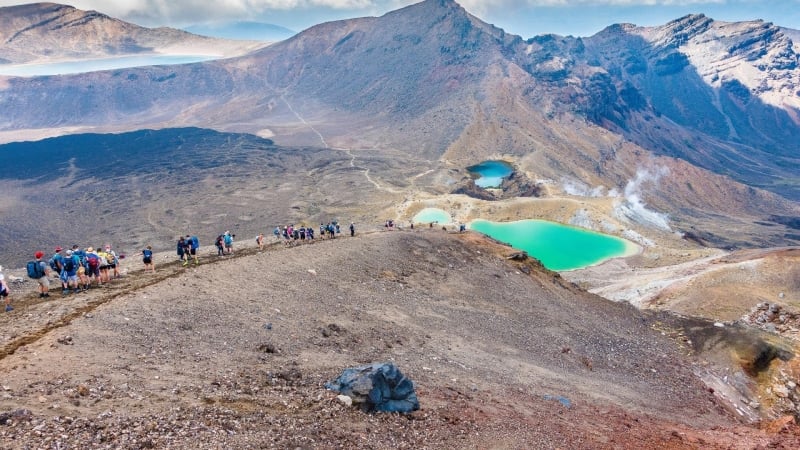
Image credit: Rod Hill via Canva Pro
A volcanic site with important Māori significance, Tongariro National Park is among the oldest natural attractions in New Zealand. It has three villages: Whakapapa, Raurimu, and Erua, all providing accommodation and tours for those willing to explore this exquisite area.
Among the many parks in New Zealand, this one is actually a dual World Heritage area: a testament to how it offers insight into both the country’s natural beauty and cultural heritage.
Moreover, this national park has the Tongariro Alpine Crossing, regarded as the best one-day trek in the country and one of the best in the world. It has intermediate difficulty, suitable for those who would like an outdoor adventure.

Image credit: Rayssa Melo via Canva Pro
For beginners who prefer a more laidback and relaxed stroll, Rotopounamu Track has a two-hour loop that provides an excellent view of Lake Rotopounamu.
5. Abel Tasman National Park

Image credit: rumboalla via Canva Pro
Among the national parks in New Zealand, Abel Tasman National Park is the smallest. Nonetheless, it still has lots to offer! Unspoilt scenery, native wildlife, and easy accessibility are some of the many perks that await you.
A unique experience you can consider to visit this area would be to take a water taxi from the regions Marahau or Kaiteriteri. Other options by water would be tours that offer cruises and sailing catamarans.

Image credit: David Tip
Those interested in trekking can try out the Pitt Head Loop. It’s a moderately difficult trek that enables you to check out coastal sights and islets.
To really spice up your trip, why not consider air and helicopter tours as well? Some tours even allow a skydiving experience, while others include a tour over other natural attractions in New Zealand!
6. Te Wahipounamu National Park
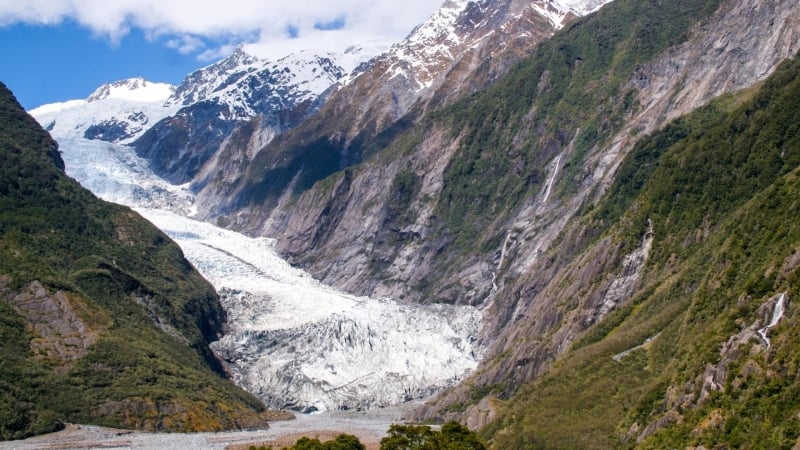
Image credit: VanderWolf-Images via Canva Pro
Te Wahipounamu National Park is one of the many must-see natural parks in New Zealand, simply because of its temperate and dense rainforest as well as its famous beautiful icy glaciers that reside in the area.
The two glaciers are Franz Josef Glacier and Fox Glacier. These are considered the world’s most (relatively) accessible glaciers, since other glaciers are often located in extreme environments. Still, in the case of these two, visitors can only access them via helicopter.

Image credit: Jackman Chiu
Phenomenally beautiful, Franz Josef Glacier is a 12km-long temperate maritime glacier. It is popular among hikers who prefer a steeper incline. It also provides a better chance of seeing the magical and pristine blue ice since Franz Josef Glacier has many ice caves and deep cracks.
On the other hand, Fox Glacier is a quieter spot with a gradual incline, suitable for those who prefer a more relaxed climb!
Also read: 5 Best Hikes in New Zealand’s Aoraki / Mount Cook National Park
Lakes, springs, and waterfalls to check out
7. Blue Pools

Image credit: Christian Mueringer . Fine Art Photograpy via Canva Pro
Blue Pools of Haast Past has one of the prettiest and clearest waters, making it a top spot for visitors wanting to enjoy nature in New Zealand. You can choose to hike on the trail and encounter a swing bridge while admiring the waters below.
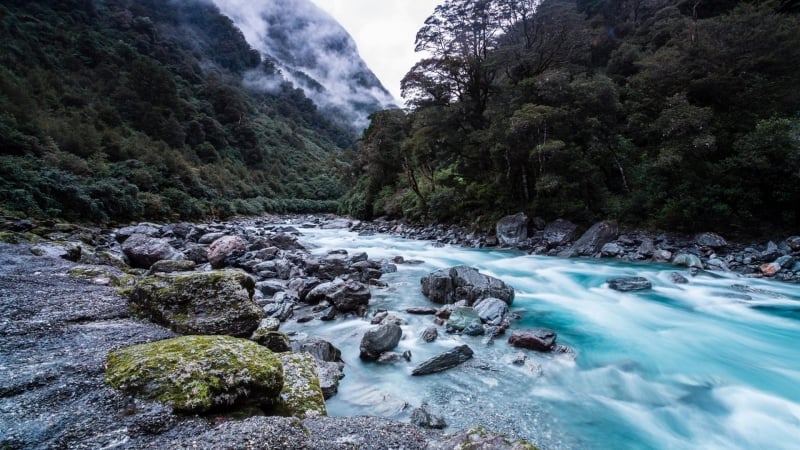
Image credit: PhotoCPL via Canva Pro
Alternatively, take a refreshing dip into the pool itself, where the waters are shallow. Make sure to avoid swimming in the rushing river; the Blue Pools are only a small section of the larger Makarora River that has strong currents.
Fun fact: Wondering why New Zealand’s waters take on such an amazing blue colour? You have glacier flour to thank for that! This fine dust has been eroded over time by the nearby glaciers. However, too much of it will turn the water murky.
8. Frying Pan Lake

Image credit: rusm via Canva Pro
Deemed the largest hot spring in the world, Frying Pan Lake comes with a rather comical name. The water appears steaming and bubbling, due to carbon dioxide and hydrogen sulfide gas bubbling to the surface. That said, this one clearly isn’t for swimming!
While you’re in this ancient area, you can also witness the extinct Waimangu Geyser located 120m south of the lake.
Pro tip: This natural beauty is located on the wheelchair-friendly Waimangu walking track.
9. Rotomairewhenua / Blue Lake

Image credit: CK NG / 500px via Canva Pro
Lake Rotomairewhenua is a small, lovely lake that should not be underestimated due to its crystal-clear waters. It is one of the many natural attractions on New Zealand’s South Island.
Best known for its extreme clarity, Blue Lake is recognised as one of the clearest freshwater lakes in the world. The water has blue-violet hues due to natural filtration from landslide debris.
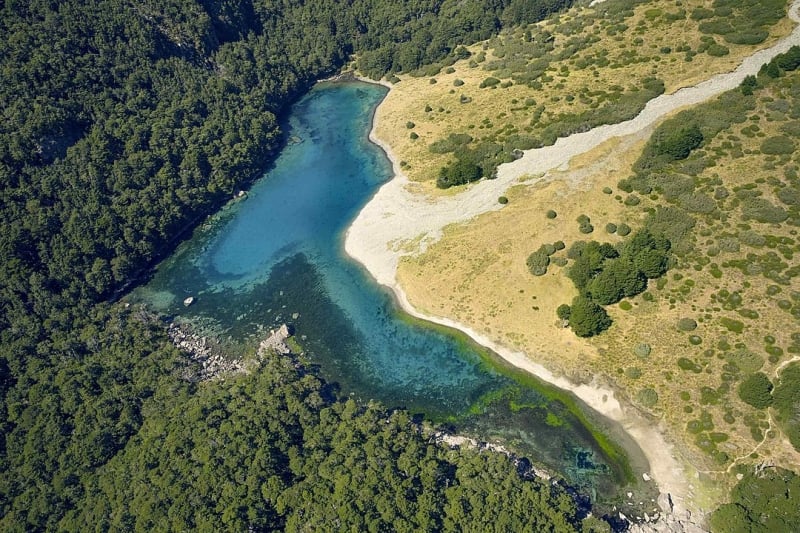
Image credit: Squashem
This lake is culturally significant to the Māori and is currently under tribal ownership. It was traditionally used in ceremonies by males to cleanse the bones and release the spirits of the dead, so they could begin their journey to Hawaiki (original home or underworld in Māori Culture).
10. Wai-O-Tapu

Image credit: kavram via Canva Pro
Wai-O-Tapu is an active geothermal area and a great place to witness nature in New Zealand. There are many hot springs here with colourful appearances, such as the Lady Knox Geyser, Champagne Pool, Artist’s Palette, Primrose Terrace, and even boiling mud pools!
This natural tourist attraction operates under the name “Wai-O-Tapu Thermal Wonderland,” run by Te Arawa Group Holdings. The business is owned by a local Māori tribe, so you can also support the community by visiting this place!

Image credit: DmitryPichugin via Canva Pro
One of the unique pools in the area is called the Devil’s Bath. Its unnatural colour is actually due to sulfur, which has turned the pond into a greenish-yellow. It definitely seems like a real-life witches’ cauldron!
11. Lake Rotomahana

Image credit: Walter Niederbauer via Canva Pro
Lake Rotomahana is a crater laker formed by the eruption of Mount Tarawera in 1886. It is one of the must-visit natural attractions in New Zealand if you would like to check out geysers and wildlife in a protected environment.
With the lake being a wildlife refuge, all hunting of birds is prohibited. The lake’s largest island, Patiti Island, is also undergoing conservation efforts to be kept undisturbed by other species that might disrupt the wildlife.
Also read: 5 Hot Springs in New Zealand That Have Picture-Perfect Views!
Beaches and bays to relax at
12. Hot Water Beach

Image credit: denizunlusu via Canva Pro
Hot Water Beach is a fun place for the kids to explore nature in New Zealand. Here, you can dig up mini hot springs hiding right underneath the sands. For best results, we recommend to visiting during low tide.
Pro tip: Remember to bring along a spade or shovel with you to experience this unique hot spring digging at this beach.
13. Tunnel Beach

Image credit: Ralf Prien via Canva Pro
With sea-carved sandstone cliffs and wind-sculptured caves, it’s no wonder that Tunnel Beach is one of the best natural sights in New Zealand.
Although many of the rock formations and cliffs here are natural, there is also a special tunnel hand-carved by Māori pioneers. You can find it at the end of a fenced track.
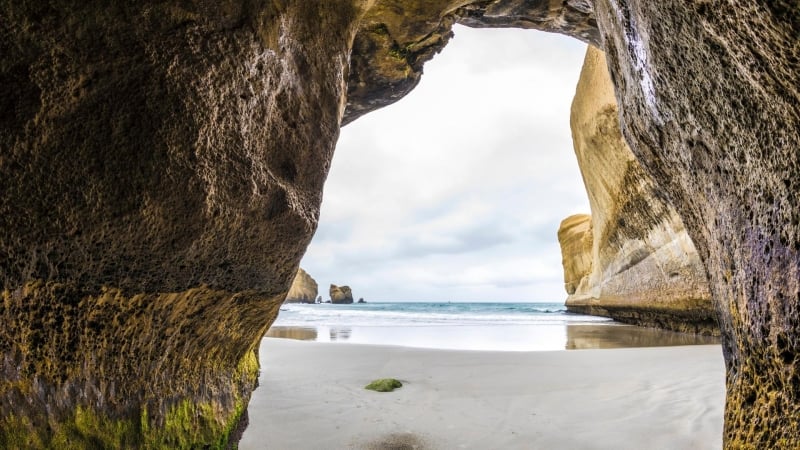
Image credit: magann via Canva Pro
This passage was created to allow easier access to a secluded cove at the base of the cliffs. As you explore the cave, be on the lookout for fossils! You may discover fragments of shells, sea urchin, or even bones of an extinct whale.
14. Farewell Spit

Image credit: Mikael Kristenson
Farewell Spit is 34km long, making it one of the longest natural sandspits in the world. With the wide sea on one side and sheltered waters on the other, it really offers the best of both worlds in terms of nature in New Zealand.
It has also served as a bird sanctuary since the 1930s, providing a home for over 90 bird species. Make sure to check out some safari tours when you visit this beach!
15. Te-Oneroa-a-Tōhē / 90 Mile Beach

Image credit: Rod Hill via Canva Pro
Even though it is named 90 Mile Beach, this natural sight in New Zealand is actually just 55 miles (89km) long! This name could have originated from how early Europeans took three days to traverse the beach. And since horses typically cover 30 miles per day, 90 miles was the estimated length back then.
Besides the rather interesting backstory, the beach has some of the best left-hand surf breaks in the world. You can even drive on the beach itself at certain hours when the tide is low.
Pro tip: Take a coach tour from the town of Kaitaia if you want to experience driving along the beach!
16. Maitai Bay

Image credit: nazar_ab via Canva Pro
A beautiful and scenic coastal location in the Kaitaia area, Maitai Bay is popular among families and boaties. You can participate in free and easy activities, such as bird-watching, diving, swimming, and snorkelling. Fishing, however, is not permitted.
Hiking treks available include the Fig Tree Track and Maitai Bay Headland Track, both of which are shorter tracks. For a longer trail, try out the Karikari Bay Track.

Image credit: Anna Jackowska via Canva Pro
It’s generally a great place to camp and unwind, since this natural attraction is a cove. You can feel nestled amongst beautiful pohutukawa trees and go star-gazing with the clear skies at night.
The most stunning feature of Maitai Bay is arguably its crescent shape, allowing you to snap picturesque photos of the scenery, as well as selfies with your travel buddies!
17. Wharariki Beach

Image credit: Simon Forster via Canva Pro
Best to visit during low tide, Wharariki Beach differs from other beaches, since it allows you to access farmland and forest regions. There are many caves and sand dunes to check out. You can even admire the two rock formations that stand regally above the water, serving as an excellent backdrop for photos.

Image credit: Rob_Weir via Canva Pro
The best activity at this beach would be horseback riding! How fun does it sound to ride across the sandy terrain on top of a horse? You can prepare by searching for some horse rentals before your visit.
Also read: 10 Best Places to See Southern Lights — Tasmania, New Zealand & More!
Forested areas to trek or mountain bike through
18. Waipoua Forest

Image credit: Yathursan Gunaratnam
Tāne Mahuta (aka God of the Forest) is a giant kauri tree in the Waipoua Forest of the Northland region. Its age is unknown but is estimated to be between 1,250 and 2,500 years old. It is the largest living kauri tree and is dedicated to the Māori god of forests and birds.
Meanwhile, the Te Matua Ngahere Walk is a good option for families with children. It is a short hike that allows visitors to check out the kauri trees.
Note: Some walks have been closed till further notice due to kauri dieback disease, which creates irreversible damage and is easily spreadable to the trees. Make sure to be respectful to the locals and the wildlife! Kauri dieback spreads through the soil, so remember to scrub off soil from your shoes and to not wander off track.
19. Whakarewarewa Redwood Forest

Image credit: Rod Hill via Canva Pro
Casually called the Redwoods by locals, the magnificent Whakarewarewa Redwood Forest in New Zealand is full of Californian redwoods.
Hikers can try out the Redwoods Treewalk, a canopy walkway suspended between the trunks. Above the walkway, wooden lantern sculptures are also suspended between the tall trees.

Image credit: brians101 via Canva Pro
Other than trekking, this area of Rotorua is filled with Whakarewarewa trails, which are highly rated by avid mountain bikers. The trails have playful names like Check It Out, Gunna Gotta, North Face, The Tickler, and Be Rude Not To.
Also read: 10 Fantastic Reasons Why You Should Visit New Zealand
Cave and rock formations to explore
20. Waitomo Caves

Image credit: mleane27 via Canva Pro
Otherworldy, spectral, mystical — there are many words to describe the beauty of Waitomo Caves. Home to the glowworms, it’s clearly among the prime natural attractions in New Zealand worth visiting.
We recommend going during off-peak hours on weekdays and taking a boat cave tour. The tour guides themselves are direct descendants of the Māori chief. With story-telling and ample explanation of the history, features, and legends of the cave, these guides are bound to help your imagination run free.

Image credit: criskorah via Canva Pro
The organisation Discover Waitomo has designated itself as kaitiaki (concept of guardianship for the sky, sea, and land). Manuhiri (non-Māori person or visitors) are not permitted to take photography or videography in the Waitomoto Glowworm Caves. This is to help prolong the survivability of the glowworms. It is, however, allowed in the nearby Ruakuri Cave and Aranui Cave.
21. Pancake Rocks and Blowholes
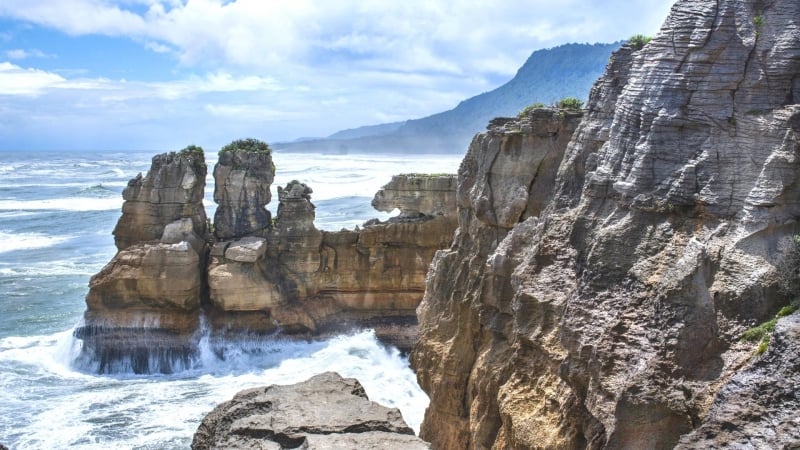
Image credit: Janachanvia Canva Pro
The most visited natural attraction on New Zealand’s West Coast, the Pancake Rocks and Blowholes in Dolomorite Point have formed due to extraordinary circumstances.
The base foundation was formed 30 million years ago when marine creatures were on the seabed. Immense water pressure solidified them into soft fossils. Gradually, they succumbed to the elements of nature and became the “pancake-like” stack of hard limestone that we see today.

Image credit: photongpix via Canva Pro
Part of the Paparoa National Park, you can easily access this unique natural feature along the Pancake Rocks and Blowholes Walk in the centre of Punakaiki. Expect the loud whooshing sounds of blowholes and seawater spraying on your face!
22. Cathedral Cove

Image credit: denizunlusu via Canva Pro
Cathedral Cove, with its natural rock archway and location in a quaint seaside village, draws many visitors wanting a taste of coastal freedom. It is only accessible by foot or by boat. To get the best views, head over to the Cathedral Cove Walk, which has many vantage points perfect for photo-ops.

Image credit: Tinnawat Ariyayotin via Canva Pro
The gigantic arched cavern is simply a sight for sore eyes, as it makes this natural location feel grand. The sandy beach also has shady pohutukawa trees along the foreshore, so you can consider having a picnic, too!
Fun fact: The cave and beach were used as the tunnel through which the Pevensie children first re-enter Narnia in the movie adaptation of The Chronicles of Narnia: Prince Caspian. The tunnel is also featured in the music video for Macklemore’s Can’t Hold Us.
23. Castle Hill

Image credit: Luca Calderone
Not to be confused with the Aussie suburb of the same name, Castle Hill is a natural feature in New Zealand that comprises limestone rock formations. The Dalai Lama even referred to it as the Spiritual Center of the Universe.

Image credit: Kimberly Loo via Canva Pro
Castle Hill was named after the imposing array of limestone boulders reminiscent of an old, run-down stone castle. Recently, this area has seen more visitors, thanks to the nearby Flock Hill which was a filming site for The Chronicles of Narnia: The Lion, the Witch, and the Wardrobe. It is also a famous South Island climbing spot, where one can find many rock climbers scaling the limestone boulders in the area.
Fun fact: The front of Christchurch Cathedral is made out of limestone from Castle Hill!
24. Elephant Rocks

Image credit: Nareeta Martin
Strangely-shaped boulders that are weathered by time rest in the area of Waitaki Whitestone Geopark. Named the Elephant Rocks, they were created after fossil-rich limestone deposited millions of years ago eroded. As a result, we are able to witness the stunning field filled with boulders today.

Image credit: Emilio Amato via Canva Pro
These are giant rocks that will tower above you. Please be respectful of the area as the Elephant Rocks are part of private land. There are proper signages to follow and do be mindful of roaming stock.
Pro tip: The photographer managed to snag a photo of a smiley face (as pictured above). Try to find the very same rock or snap special photos of carvings on other rocks!
25. Moeraki Boulders

Image credit: Lode Lagrainge
After encountering the Elephant Rocks, these are other pretty odd-shaped boulders that almost resemble coconut shells lying on the beach. These are actually the Moeraki Boulders, located on the coastline of North Otago. An astonishing natural sight, these are something you would want to explore for yourself in real life.
Scientists have determined that these rocks are calcite concretions formed about 65 million years ago.

Image credit: Martin Vlnas via Canva Pro
According to Māori legend, the boulders are gourds washed ashore from a giant canoe that carried the Maori chiefs to New Zealand via the northeast wind. How cool is that?
26. Split Apple Rock

Image credit: Pablo Heimplatz
This geological rock formation nicknamed Split Apple Rock is certainly one of the more fascinating natural attractions in New Zealand. Emerging from the waters with a direct clean split in the middle, it’s an amazing creation that highlights the wonder of nature.
The precise and clean cut of the rock is due to a naturally occurring joint, which is seen often in rocks such as granite. These joints are often attacked by rain and waves, eventually resulting in an even split. Meanwhile, the Māoris believe that the occurrence of the rock is due to two powerful gods who broke apart the rock.
Also read: 15 Useful Māori Phrases & Basic Greetings for Your Future Trip to New Zealand + Fun Facts!
Well, we hope that you’re done feasting your eyes on these natural attractions in New Zealand! These lovely, picturesque sights are simply to die for, and we promise that they are worth the visit. To all nature lovers, take note of some of these places to add to your travel bucket list!





